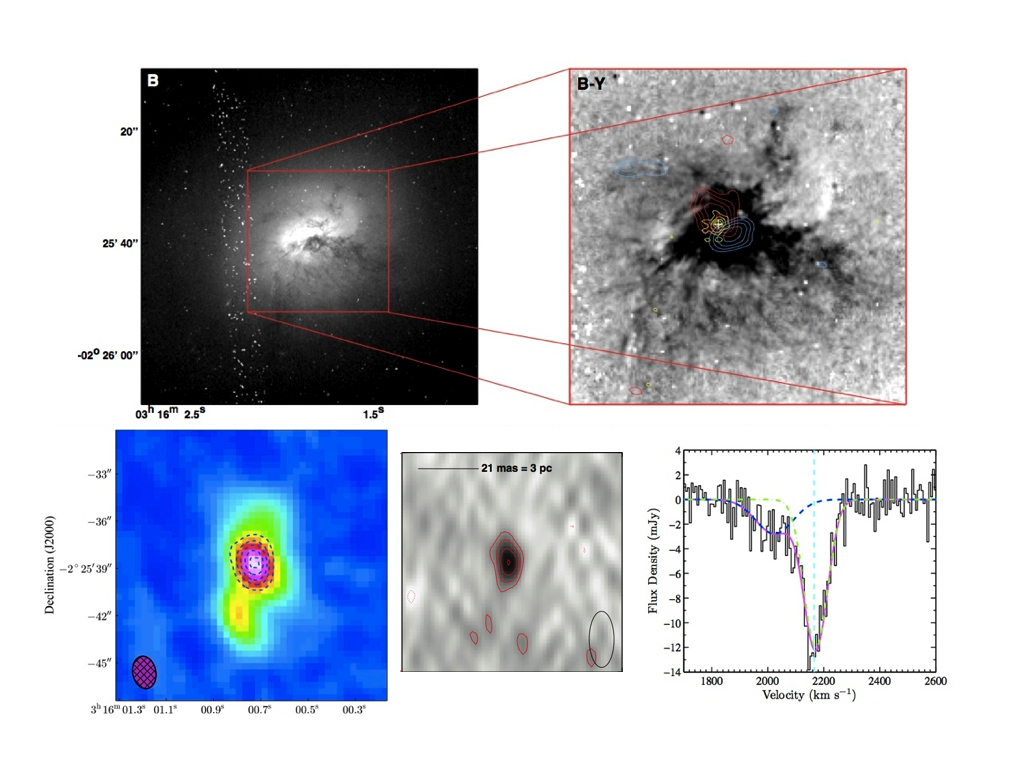Daily Image
24-01-2014The power of wimpy radio sources
| Submitter: | Raffaella Morganti, Kristina Nyland (New Mexico Tech/NRAO) |
| Description: | In recent years, a lot of interest and observing time has been devoted to the study of gas outflows generated by active galactic nuclei (AGN). These outflows are thought to have a major impact on the evolution of the host galaxy, by clearing the galaxy from gas and, in particular, cold gas. By getting rid of this potential fuel for star formation, the outflows represent the most likely mechanism to produce so-called "red and dead" galaxies, galaxies where both the star formation and the growth of the central black hole have stopped. However, if only a very powerful active nucleus can produce such outflows, their occurrence would turn out to be too rare to be interesting and useful to explain the widespread presence of "red and dead" galaxies. Thus, a lot of effort is now invested to understand whether also active nuclei considered to be "wimpy" release enough energy to be able to power massive gas outflows. In a recent paper led by Kristina Nyland (New Mexico Tech/NRAO), and co-authored by Raffaella Morganti, VLBA observations have been used to investigate whether such wimpy radio sources can also drive outflows. Indeed, one such "wimpy" radio source is at the centre of the galaxy NGC 1266. In this object, outflows of molecular gas and HI are observed (see Figure), depleting the galaxy of 13 solar masses of molecular gas every year. This is higher than the star formation rate in the galaxy, therefore suggesting that in the not-too-far-away-future (85 Myr) this galaxy will be completely devoid of gas. The VLBA observations at 1.65 GHz reveal a continuum source within the densest portion of the molecular gas, with a diameter d < 8 mas (1.2 pc), a radio power P_rad = 1.48 × 10^20 W Hz^−1, and a brightness temperature Tb > 1.5 × 10^7 K, which is most consistent with an AGN origin. The radio continuum energetics implied by the compact VLBA source, as well as archival VLA continuum observations at lower spatial resolution, further support the possibility that the AGN in NGC 1266 could be driving the molecular outflow. These findings suggest that even low-level AGNs may be able to launch massive outflows in their host galaxies. These results have been presented in a paper by Nyland, Alatalo, Wrobel, Young, Morganti et al. Astrophysical Journal 779, 173 http://arxiv.org/abs/1310.7588 ). Figure caption: (Top left) HST image of NGC1266, (Top right) CO contours superimposed to the zoomed-in HST image, showing the distribution and kinematics of the molecular gas (red and blue contours tracing the extended outflow). (Bottom) continuum emission from VLA data (left) with dashed contours marking the location of the HI absorption and from the 1.65 GHz VLBA (middle). (Bottom left) HI absorption profile from the VLA showing the blueshifted wing. |
| Copyright: | Kristina Nyland, ApJ |
| Tweet |  |
